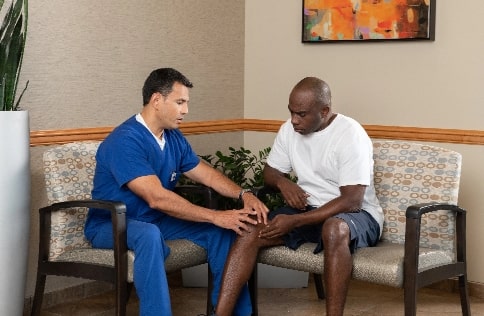
Knee pain

The knee acts as a bony hinge between the three bones in the upper and lower leg bones. Tough elastic cartilage covers the knee joint. Connective tissue discs called menisci act as shock absorbers between the bones. Groups of muscles, tendons and ligaments bind the structure together.
Watch this before your knee surgery
The joint replacement team created the following video especially for patients undergoing knee replacement surgery. Please take time to carefully view the video before your scheduled surgery.
Types of knee problems
Common knee conditions include:
- Osteoarthritis (the most common form of arthritis)
- ACL injury
- Meniscus tear
- Patellofemoral pain syndrome
- Bursitis
- Tendinitis
- Osteochondritis dissecans
- Knee fracture
- Shin splints
- Deep vein thrombosis
- Iliotibial band syndrome

Who should you see about knee pain?
Physicians trained to provide comprehensive medical treatment for bones, joints, ligaments and tendons – the entire musculoskeletal system – are known as orthopedic specialists.
Baylor Scott & White Orthopedic and Spine Hospital – Arlington provides a facility where orthopedic surgeons, general orthopedists, sports medicine doctors, and other specialists can focus on treating knee pain.
These orthopedic specialists use advanced diagnostic imaging tools (such as MRI, digital fluoroscopy, arthrograms, and myelograms) to assess the knee, then determine recommended treatments.
Your next steps to stop knee discomfort
To set up an appointment with an orthopedic knee specialist, call 1.855.41.ORTHO.
For a traumatic knee injury, patients may visit the 24-hour orthopedic emergency department at Baylor Scott & White – Arlington.
Knee doctors can offer a comprehensive knee treatment plan, including:
- Pain management
- Physical therapy
- Injections
- Rehabilitation programs
- Minimally invasive arthroscopic knee surgery
- Knee replacement surgery
Our team looks forward to assisting you in your journey toward an improved level of activity and higher quality of life following your treatment.
Are you a candidate for total knee replacement surgery?
In the United States, more than 600,000 total knee replacements are performed each year.
Typically, candidates for this surgery are individuals with chronic knee pain from arthritis that severely diminishes their ability to perform normal daily activities. This often leads to a loss of independence and self-esteem.
A replacement knee can make a big difference in your ability to return to work or other activities that you enjoy.
What is the recovery time for total knee replacement surgery?
Patients undergoing any total joint replacement surgery, including on the knee, typically recover quickly.
The hospital stay is two to three days, on average. New surgical techniques, such as robotic-assisted surgery, and improved analgesic methods have allowed us to quicken the recovery process. In fact, most patients will be expected to walk on the day of surgery.
Quick recovery allows the return to most activities in six to eight weeks for motivated individuals. This includes driving, walking distances, swimming and golfing.
How quickly you return to normal activity is highly dependent on your preoperative physical conditioning. The better your physical condition is prior to surgery, the quicker your recovery to more normal activity will be. Patients who take an active role in their recovery experience the most positive results.

Your Guide to Total Knee Replacement
Robotic technology ensures the perfect fit for implants
Your individual anatomy is unique, so knee replacement surgery requires a tremendous amount of care and precision for just the right fit and placement of your knee implant. When the knee feels natural, you can:
- Recover and regain your motion faster
- Enjoy the same activities from your pre-surgery life
- Comfortably live with your replacement joint for decades
At Baylor Scott & White – Arlington, we perform many knee replacement surgeries using sophisticated robotic technology. This technology uses data collected before and during surgery to help your surgeon position your implant in the exact right spot. Just a fraction of an inch can mean the difference between a perfect, natural-feeling knee and an uncomfortable, awkward implant that may even require surgical revision.
How It Works
The actual procedure is similar to a traditional total knee replacement, but with a robotic assistant. It’s important to understand that the robot does not operate on its own. That means it does not move unless your surgeon prompts it to. Your surgeon is still in the operating room the entire time and is making all the decisions throughout your surgery.
Robotic surgery is minimally invasive, so patients experience less blood loss and fewer post-operative complications. The biggest benefit, however, is the precise placement of the implant based on your unique anatomy.
Are You a Candidate?
Robotic surgery is a fantastic option for many patients. However, it is not right for everyone. Ask your doctor if you are a good candidate for robotic-assisted knee replacement surgery.

Contact Us Now
